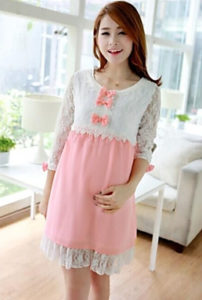 During pregnancy, many women want to dress stylishly and beautifully. In addition, clothing should be comfortable and practical. Unfortunately, finding the desired item in stores can be quite problematic. Patterns and recommendations for sewing clothes for pregnant women come to the rescue.
During pregnancy, many women want to dress stylishly and beautifully. In addition, clothing should be comfortable and practical. Unfortunately, finding the desired item in stores can be quite problematic. Patterns and recommendations for sewing clothes for pregnant women come to the rescue.
Which dress is best?
 Traditionally, women try to hide their rounded belly. However, there are girls who, on the contrary, want to emphasize their interesting position and choose shorter and tighter clothes. Pregnant women should primarily choose dresses that are comfortable and do not restrict movement. You should understand that the tummy will grow rapidly. Therefore, it is better to choose a dress style that will be possible to wear during all the months of an interesting situation.
Traditionally, women try to hide their rounded belly. However, there are girls who, on the contrary, want to emphasize their interesting position and choose shorter and tighter clothes. Pregnant women should primarily choose dresses that are comfortable and do not restrict movement. You should understand that the tummy will grow rapidly. Therefore, it is better to choose a dress style that will be possible to wear during all the months of an interesting situation.
ATTENTION! Working women choose comfortable clothes for the whole day. Thus, the trapeze sundress is especially popular. They can be worn with warm turtlenecks and light blouses, as well as without them.
What fabric to choose for sewing a dress for a pregnant woman
 When choosing materials for sewing, you should pay attention to the structure of the fabric, as well as its flowability. It is recommended to use fabrics that have good stretch. They will help ensure a good fit of the product. Wool knitted or cotton knitwear, as well as other natural fabrics, are popular.
When choosing materials for sewing, you should pay attention to the structure of the fabric, as well as its flowability. It is recommended to use fabrics that have good stretch. They will help ensure a good fit of the product. Wool knitted or cotton knitwear, as well as other natural fabrics, are popular.
Dress patterns for pregnant women: overview of options
Most sewing patterns are not particularly difficult. They have only five or six straight seams, and only pockets as additional details. You can find many examples and recommendations for making maternity dresses, even without creating patterns. Outfits for girls in an interesting position are divided into the following types:


- high waisted;
- case;
- sundress;
- low waist;
- shaped like a bag;
- trapezoidal shape.
IMPORTANT! High-waisted models are especially popular. These include wrap dresses, tunics, Greek dresses, as well as products with a cut-off bodice.
How to sew a dress for a pregnant woman with your own hands
 First, you should choose a suitable outfit model and build a competent drawing, having worked out all the nuances in advance. Patterns are easy to find on the Internet, as well as in specialized magazines. There are styles for which you don’t have to create a pattern at all. Such options include a dress in the Greek style, which is a piece of fabric and a belt.
First, you should choose a suitable outfit model and build a competent drawing, having worked out all the nuances in advance. Patterns are easy to find on the Internet, as well as in specialized magazines. There are styles for which you don’t have to create a pattern at all. Such options include a dress in the Greek style, which is a piece of fabric and a belt.
So, it’s convenient to draw a pattern based on clothes that already exist in your wardrobe. To do this, take any sweater or turtleneck and trace it on tracing paper. The length is of your choice. If desired, you can draw sleeves. The pattern is cut out and traced onto the fabric with a piece of soap.
Making a dress pattern
Let's look at the process of designing one of the most fashionable sleeveless dresses with an extended back. The main measurements will be the chest circumference and the length of the product. It is much more convenient to create a pattern for pregnant women using the basic classic model. It just needs to make some changes. Strictly follow the specific sequence of actions:

- First you need to move the dart to the waist area. To do this, it must be closed on the chest.
- The flare of the skirt should be increased by 5–6 cm or more.
- Add about 7 cm to the side to the front.
- In addition to the base, we draw a triangular insert with a length equal to the distance from the bottom point of the neck to the end of the product. The width of the triangle should be 30 cm. This part should have a slight curve downwards.
- The back of the pattern should be extended from the edge to the center by 10 cm and also rounded.
- Next, mark a line in the drawing and cut off part of the back along it, leaving a fold of about 6 cm.
- Next, you should measure the facings to process the notch of the sleeves and neckline from the back.
- Then we measure and draw in natural size the elements of the front, back, front insert, as well as the facings for the armholes and neckline for the back and front.
By following this principle, you can transform almost any pattern into a dress pattern for pregnant women.
REFERENCE! When cutting, it is necessary to add up to an additional 1.5 cm for processing the seams, as well as 2 cm for hemming the bottom.
Step-by-step sewing of a dress
Let's look at the process of sewing a dress with an insert. Follow a certain sequence of actions:
 We sew together the front elements and the insert. In this case, the reserves on the seams must be processed.
We sew together the front elements and the insert. In this case, the reserves on the seams must be processed.- Folds should be placed on the back parts.
- Next, we sew the shoulders and side sections of the dress.
- We sew a hidden zipper on the back. It is more convenient to place it in the center of the product. Sometimes it is sewn into the side. In this case, it is necessary to leave additional space. First, the edges of the parts are processed with an overlocker and, if desired, reinforced with bias tape. Using a piece of soap, make a mark where the zipper will be sewn in, no more than 15 cm. Next, we apply the open zipper to the seam of the part in such a way that the teeth rest exactly on the edge of the material. Before sewing, you need to check the zipper to ensure that it opens and closes well.
- Next we proceed to processing the armhole and neckline. To do this, you should prepare facings in advance. They need to be connected right sides together and stitched on a typewriter.
- Next, a finishing and securing stitch is sewn a couple of millimeters from the edge.
- Then we process the bottom of the dress. It is recommended to finish the edge using a serger and then hem the edge. They also double fold the material.
How to decorate a dress for a pregnant woman
 There are no fixed regulations for decorating such products. In most versions, everything depends on the author’s imagination. You can use lace ribbons, embroidery, bows, and painting with acrylic paints on fabric. These decorative methods will help not only decorate the product, but also hide possible defects.
There are no fixed regulations for decorating such products. In most versions, everything depends on the author’s imagination. You can use lace ribbons, embroidery, bows, and painting with acrylic paints on fabric. These decorative methods will help not only decorate the product, but also hide possible defects.
Hand-sewn clothes will be a worthy alternative to long shopping trips in search of the right item or large sums of money to purchase. After all, pregnancy is not a reason to give up holidays, work and an interesting and varied life.


 We sew together the front elements and the insert. In this case, the reserves on the seams must be processed.
We sew together the front elements and the insert. In this case, the reserves on the seams must be processed. 0
0





